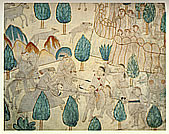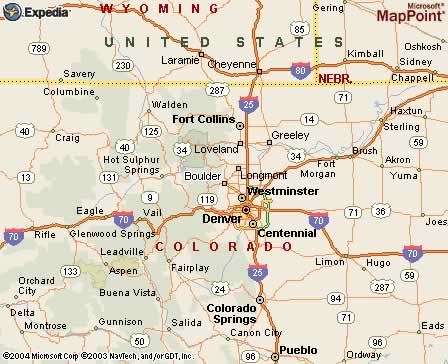|
|
Canku Ota |
|
|
(Many Paths) |
||
|
An Online Newsletter Celebrating Native America |
||
|
April 17, 2004 - Issue 111 |
||
|
|
||
|
Rock Art Depicting Comanches, Horses Clad In Leather Armor Discovered In Colorado By CU Researcher |
||
|
by University of Colorado at
Boulder press release
|
||
|
credits: graphic:
Mounted warriors on leather-armored horses attack a band of Apache
Indians in this hide painting by an American Indian. Produced in
a Jesuit mission in present day New Mexico, circa 1720.
|
|
CU-Boulder anthropology doctoral student Mark Mitchell, who identified the art, said Plains Indians like the Comanche probably acquired horses from the Spanish in northern New Mexico beginning about 1650 through raiding or trading. The idea of leather-armored horses and riders to deflect spears and arrows probably came from American Indians seeing armored Spanish horse soldiers in the Southwest or Mexico. "This art tells us about Comanche history through archaeology," Mitchell said. "There is some recorded history but virtually no archaeology of the Comanche, which makes these rock art depictions very valuable. They should point us to additional places to look for Comanche sites containing artifacts associated with horses." The new finds by Mitchell include three in Colorado and one in central Kansas. He identified two separate rock art depictions of armored horses on the Purgatoire River in southeast Colorado, both showing the horses' armor as rough trapezoids of leather on each side with straight to slightly flaring front and back margins and curved at the top and bottom. "Both also clearly show an armored collar from which horses' heads protrude," said Mitchell. A third petroglyph in Baca County depicts a single armored horse and rider incised in rock, he said. The horse's feet and head are shown protruding from the armor. Two parallel lines adjacent to the rider's torso may represent human body armor, and the rider holds a short lance in his left hand. Mitchell published a paper on the subject in the March issue of Antiquity. Previous rock art discoveries as far north as Canada, which appear to date several decades later than those on the southern plains, indicate northern Plains Indians also used leather armor to protect the horse and rider. But cavalry tactics on the northern plains appear to have been less sophisticated than those in the south. The fourth petroglyph identified by Mitchell, from central Kansas, "clearly depicts an armored horse," he said. The armor again is trapezoidal in shape and shows a horse head protruding from an armored collar. The leather-armored Comanche likely used short bows, arrows and spears during battle. The best historical evidence for armored and mounted Plains Indians comes from a hide painting produced in a Jesuit mission in present-day New Mexico by an American Indian in about 1720, said Mitchell. The painting depicts a band of mounted warriors on leather-armored horses and holding spears, attacking a ground force of Apache Indians holding shields, spears and bows and arrows. "This strategy of leather armor only lasted for about a century, from 1650 to 1750," said Mitchell. Referred to as the "Post-horse-Pre-gun" period, it collapsed as firearms became available to American Indians via trades with the French and English, which could penetrate the leather armor of mounted warriors. Mitchell noted a previous study by University of Nebraska archaeologists indicated French traders may have visited and perhaps traded guns to the Comanche as early as 1748. The Comanche also may have been trading with the Wichita and Pawnee by 1751. Many anthropologists now believe some Plains Indian tribes moved south specifically to obtain horses from the Spanish, he said. Some Comanche bands may have had a dozen horses per warrior, forcing them to camp near large lakes or rivers in order to keep the people and horses watered. The period of mounted Indian warriors, including the century of some using armored hides, is a relatively brief but significant blip in the history of the Plains Indians, Mitchell said. "For the previous 1,000 years, these peoples were very sedentary, living in villages and farming, and were not mobile until the arrival of the horse."
|
|
|
www.expedia.com |
|
|
||
|
|
||
| Canku Ota is a free Newsletter celebrating Native America, its traditions and accomplishments . We do not provide subscriber or visitor names to anyone. Some articles presented in Canku Ota may contain copyright material. We have received appropriate permissions for republishing any articles. Material appearing here is distributed without profit or monetary gain to those who have expressed an interest. This is in accordance with Title 17 U.S.C. Section 107. | ||
|
Canku Ota is a copyright © 2000, 2001, 2002, 2003, 2004 of Vicki Lockard and Paul Barry. |
||
 |
 |
|
|
The "Canku Ota - A Newsletter Celebrating Native America" web site and its design is the |
||
|
Copyright © 1999, 2000, 2001, 2002, 2003, 2004 of Paul C. Barry. |
||
|
All Rights Reserved. |
||
 Several
new rock art discoveries by a University of Colorado at Boulder
researcher depict mounted warriors, likely Comanche, astride horses
clad in leather armor and created around 1700 to 1750, the first
such petroglyphs found in the state.
Several
new rock art discoveries by a University of Colorado at Boulder
researcher depict mounted warriors, likely Comanche, astride horses
clad in leather armor and created around 1700 to 1750, the first
such petroglyphs found in the state. 